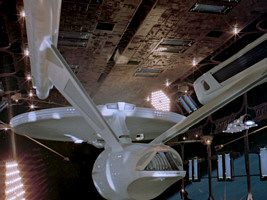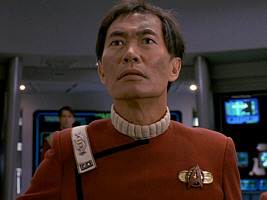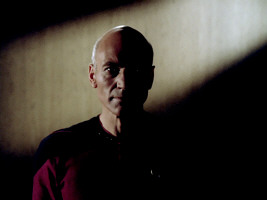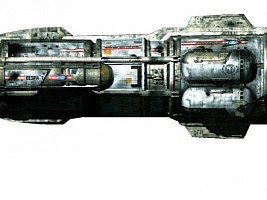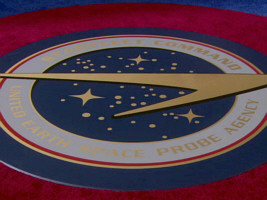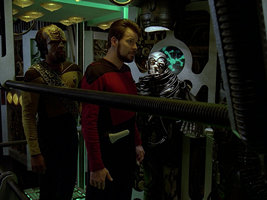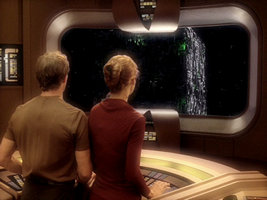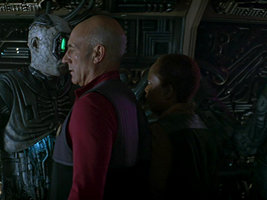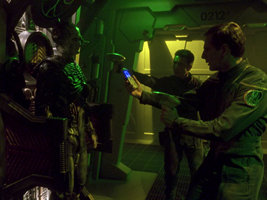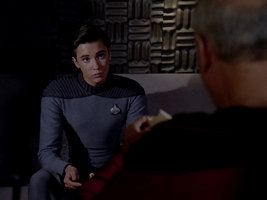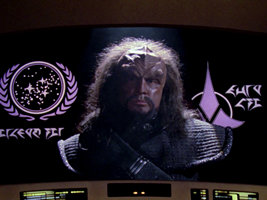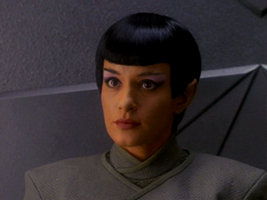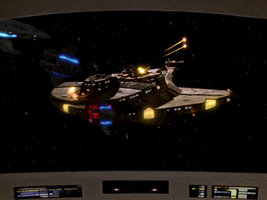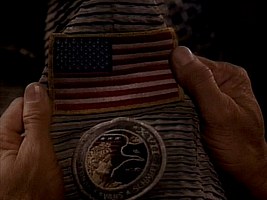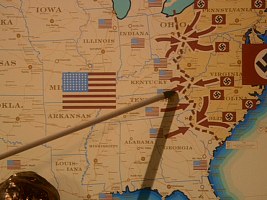Other History Inconsistencies
Timeline of the TOS MoviesUESPA vs. StarfleetFirst Contact with the BorgKlingons in the Federation?History of the MaquisMiscellaneous
Timeline of the TOS Movies
According to the Star Trek timeline as outlined most notably in the Star Trek Encyclopedia, the first season of TOS is set in the year 2266, "Star Trek: The Motion Picture" takes place in 2271, "The Wrath of Khan" in 2285, and TNG begins in 2364. However, the dates of the TOS movies may have to be reconsidered based on the following points of reference:
- TOS: "Journey to Babel": Sarek is 102.437 years old. Together with TNG: "Sarek" this episode gives a point of reference for the TOS part of the timeline.
- "Star Trek: The Motion Picture": It takes place at least two and a half years after the end of the series and thus the end of Kirk's five-year mission.
- "Star Trek II: The Wrath of Khan": Kirk mentions that he did not see Khan for 15 years. It is unclear whether the label 2283 on the Romulan ale means a stardate or a year (and of which calendar?).
- "Star Trek III: The Search for Spock": It takes place almost immediately after TWOK.
- "Star Trek IV: The Voyage Home": It takes place three months after TSFS.
- "Star Trek V: The Final Frontier": It takes place at least three weeks after TVH.
- "Star Trek VI: The Undiscovered Country": It takes place 27 years after McCoy's first appearance in TOS. Sulu has been the captain of the Excelsior for at least three years.
- "Star Trek: Generations": Nine years prior to his disappearance in the Nexus Kirk decided to rejoin Starfleet.
- TNG: "The Neutral Zone": It is the year 2364. And this was the first time a specific year was mentioned, making this the one of the major points of reference.
- TNG: "Sarek": Sarek is 202 years old. Together with "Journey to Babel" this episode gives a point of reference for the TOS part of the timeline.
- TNG: "Cause and Effect": The red movie uniforms are worn already in 2278.
- DS9: "Trials and Tribble-ations": It takes place 105 years, one month and twelve days after TOS: "The Trouble with Tribbles".
- VOY: "Q2": Kirk's five-year mission ends in 2270.
There are also a couple of references to the 20th or 21st century that we may take into consideration:
- TOS:"Tomorrow is Yesterday": Fellini says to Kirk, "I am going to lock you up for 200 years", which Kirk comments with "That ought to be just about right." This would put the first season of TOS into the late 22nd century, but clearly it is a joke and accordingly inaccurate.
- TOS: "Space Seed": Kirk tells Khan, "You have 200 years of catching up to do." The episode would take place around 2200 if Kirk were right, but once again it's only a casual mention.
- "Star Trek II: The Wrath of Khan": Khan complies with Kirk's estimation, saying "On Earth, 200 years ago, I was a prince." He says that at a time when already close to 300 years have passed.
These three references would predate TOS by some 100 years, as it was the intention when the series was being produced. Since this is in contradiction with everything else stated about the century TOS takes place, we may want to claim that Kirk and Khan suck at numbers (or, at least regarding Khan, redate the Eugenics Wars).
This gives us the following chronology, if we go by definite references only:
- The first season of Star Trek: The Next Generation takes place in 2364.
- The third season of Star Trek: The Next Generation takes place nearly 100 years after the second season of the original Star Trek, placing the second season of TOS in 2267, because "Sarek" happened near the end of its season and "Journey to Babel" around the middle of its season.
- "Star Trek: The Motion Picture" takes place between 2273 and 2278.
- "Star Trek II: The Wrath of Khan" takes place fifteen years after the first season of TOS, placing the movie in 2281.
- "Star Trek III: The Search for Spock" and "Star Trek IV: The Voyage Home" take place in a period of a little over three months after "Star Trek II: The Wrath of Khan", placing these movies also in 2281.
- Kirk left Starfleet some time after the events of "Star Trek IV" in 2281, and decided to return not before 2284.
- "Star Trek V: The Final Frontier" takes place between 2284 (Kirk's return) and 2290 (three years before "Star Trek VI: The Undiscovered Country").
- "Star Trek VI: The Undiscovered Country" takes place 27 years after the first season of "Star Trek", placing the movie in 2293.
- The fifth season of Star Trek: Deep Space Nine takes place nine years after the first season of "Star Trek: The Next Generation" and 105 years after the second season of TOS, placing this season in 2373 and the second season of TOS in 2268. This establishes that all seasons of Star Trek begin midyear.
Some conclusions are not mandatory, considering that Kirk's casual mention that he hasn't seen Khan for fifteen years may be only an approximate reference. Icheb's statement on Kirk's five-year mission ending in 2270, on the other hand, is quite reliable, considering that he has done research on the topic that he presents to Captain Janeway. Indeed, this would not allow TMP to take place prior to 2273. Still, I will stick to the "official" year of 2271 at EAS, considering that it is only a small deviation and that it would cause unnecessary confusion and extra efforts to explain it once I decided to change it.
UESPA vs. Starfleet
The term "Star Fleet" for the organization that the Enterprise is a part of is first used in TOS: "Court Martial". However, a few episodes later in TOS: "Tomorrow is Yesterday", Kirk mentions the United Earth Space Probe Agency (UESPA) to 20th century Air Force Captain John Christopher.
Christopher: "Must have taken quite a lot to build a ship like this."
Kirk: "There are only twelve like it in the fleet."
Christopher: "I see. Did the Navy..."
Kirk: "We're a combined service, Captain. Our authority is the United Earth Space Probe Agency."
Christopher: "United Earth?"
Kirk: "This is very difficult to explain. We're from your future."
All later Star Trek episodes of TOS, TNG, DS9 and Voyager assume that Starfleet already existed as soon as 2161. In the first 13 years of modern Trek, UESPA is never once mentioned. The acronym resurfaces as late as on the probe Friendship One (VOY: "Friendship One") from the year 2068, which is labeled with "UESPA", though it is not recognizable on screen. So it looks like UESPA was something like Starfleet's precursor, prior to the foundation of both the Federation and Starfleet in 2161.
Prior to the series Star Trek Enterprise there used to be a good retcon for Kirk's statement in "Tomorrow is Yesterday". Kirk obviously does not want to confuse Christopher, a man from the 20th century, too much. To Christopher it is already a leap of faith to accept the idea of a United Earth, and it would be even harder for him to understand that Earth could be a part of an interstellar alliance with alien cultures. It is possible that Kirk remembers his history lessons and just picks the UESPA as a convenient reference, where "Earth" is the keyword, rather than "Planets". However, even without Enterprise establishing that an organization named "Starfleet" even predates the foundation of the Federation, why wouldn't he just say "Our authority is Earth Starfleet", rather than speaking out the much more complicated term UESPA? In this respect it is a better explanation that in 2266 the UESPA might still exist as a (scientific?) branch of Starfleet. In this case Kirk technically wouldn't even lie to Christopher.
Star Trek Enterprise, however, establishes the name "Starfleet" as soon as 2151. This initially seemed to make Kirk's statement only more incredible, since he would refer to an organization that ceased to exist more than a hundred years ago, prior to the foundation of the Federation. But eventually we are shown a seal with the clearly legible inscription "Starfleet Command - United Earth Space Probe Agency" in ENT: "Demons". In other words, Starfleet seems to be just a department of an even bigger agency called UESPA. This doesn't exclude that the UESPA was later disbanded or renamed to "Starfleet", but showing them in co-existence at the same time at least it reconciles the two names.
First Contact with the Borg
The history of Federation-Borg encounters seems to have changed every time writers came up with new stories about them, eventually predating this event by centuries in "Star Trek: First Contact" and in ENT: "Regeneration".
- When Q throws the Enterprise-D far into the Beta Quadrant in TNG: "Q Who" in 2365, evidently no one has ever heard of the Borg or recognizes their characteristic cubic vessel, not even Picard. Only Guinan knows them because her people has been assimilated by them. At this point it is easy to explain in that it was actually the first Federation contact with the Borg who come from an uncharted region far away.
- "Star Trek: Generations" establishes the fact that the Borg invaded El-Auria in the 23rd century and El-Aurian refugees came to the Federation territory as soon as 2293, including Guinan and Soran. Someone must have told Starfleet about their fate, if not explicitly warned them of the Borg.
- In VOY: "Infinite Regress", the Federation ship USS Tombaugh is mentioned to have been assimilated 13 years before, which would have been in 2362.
- VOY: "Dark Frontier" has the Hansens search for the Borg apparently on behalf of Starfleet in 2354. Even worse, young Annika plays with a Borg Cube™ toy, which indicates that the Borg can't be that mysterious. Agreed, the cube was obviously built by Magnus Hansen, but it must be based on descriptions by someone who encountered the Borg and survived. It is unlikely that Hansen, who was not really among the most renowned scientists, was the only one to know about it.
- The Borg travel back to the year 2063 in "Star Trek: First Contact", to erase the first contact of Earth with the Vulcans from history and allow an easy assimilation of the planet. Picard's crew thwarts the plan, but at least Lily Sloane witnesses the presence of the Borg. Also, debris of the Borg sphere remains on Earth, which is found in ENT: "Regeneration" and leads to the assimilation of a research team and of a Tarkalean crew. Moreover, Zefram Cochrane mentioned the "cybernetic species" that the Enterprise-E crew was fighting against in an address at Princeton University as soon as in 2064.
We may disregard the Tombaugh incident, since there are probably no records on the ship's assimilation and it may be simply denoted as missing in Starfleet files. Therefore the Q incident in 2365 would be the first encounter on record of Starfleet with the Borg, but there must have been reports about them before. This raises several questions.
Q: Why didn't Guinan tell Picard about the imminent Borg danger in time, knowing that nothing could have stopped them?
A: The El-Aurians had come a long way from their home, and while they almost definitely told Starfleet about their oppressors, it was probably a report taken down by some minor officer and maybe it was filed as being of little interest. We cannot really know what kind of information would have been regarded as relevant, but perhaps, with so many imminent dangers, 2290's Starfleet wouldn't be too concerned with a vague threat on the other side of the galaxy. Explaining why Guinan didn't talk to Picard about this part of her past (of several hundred years) is rather easy, considering that it's not like she was totally forthcoming about anything else either. El-Aurians listen, they don't talk.
Q: Why isn't Picard as a high-ranking officer informed about them, whereas civilian researchers were let into the Borg secret several years before?
A: It is possible that the Borg were not really a secret but, as suggested above, they were just forgotten 60 years after the events in "Generations". The Hansens may have been the first to dig up the old El-Aurian files since that time. Maybe it was not really that the Hansens were sent, maybe they were not even authorized to seek for the Borg. Would Starfleet allow two civilian scientists to go off with their infant child alone on a starship on a journey of many years, hunting a vague threat on the other side of the galaxy? Perhaps they actually misled Starfleet about what their true intentions were, and were given the ship for a simple charting mission in the near Beta Quadrant or some other unsuspicious purpose. Starfleet would have been aware that they would have had to cross the Neutral Zone as a shortcut and nevertheless stay away for years to seek for the Borg, so it is even less likely that this was their official mission.
Q: Why didn't the Borg come looking for the Hansens' point of origin?
A: It was just one ship, from a long way away, and they probably didn't seem all that impressive. After all, the Borg didn't bother to assimilate the ship in months while the Hansens were following them. It was only 10 years later or so, when they met the Enterprise-D, which appeared suddenly in their space, was packed with goodies, and then managed to whisk its way back home by means unknown to the Borg (who didn't know it was Q), that they decided this was of sufficient interest to investigate in their own heavy-handed way.
Q: What about the witnesses of the Borg attack in 2063?
A: The explanation becomes more difficult in consideration of the events from "Star Trek: First Contact". Perhaps we can assume that no one else but Cochrane and Sloane knew the whole truth. Archer mentions a speech at Princeton 89 years ago, in 2064, in which Cochrane talked about the Borg. As T'Pol notes, no one may have given the notorious drinker much credence. Then again, he was a hero for whom a statue was erected and he lived on for many more years until he finally disappeared. In Lily Sloane's case, she may have preferred not to talk about the Borg, and perhaps she even didn't live long after the events of "First Contact".
Q: But what happened to the very definite evidence of the Borg from 2153?
A: "Regeneration" changes the whole issue. With the debris on Earth, the examination of the Borg biology and technology, the disappearance of the transport, the deaths of the research team, Phlox's temporary assimilation and the many eye witnesses on Enterprise, there is plenty of evidence about the Borg that should be still remembered or at least available in the 24th century. The Federation should have remembered these events, rather than possible tales of the El-Aurians from a remote world. Moreover, scientists should have recognized that it was the same cybernetic race in both cases, which should have given the Borg threat much more relevance. Summarizing, it would be very hard to believe why the Hansens were chasing an apparent mystery and why no one on the Enterprise-D remembered reading of the Borg or bothered to look up the databases.
Klingons in the Federation?
While they are en route to Starbase 515 in TNG: "Samaritan Snare", Picard is talking of his early days in Starfleet and the incident with the Nausicaans, when Wesley poses a surprising question.
Wesley: "Was that before the Klingons joined the Federation?"
Picard: "That's right."
So are the Klingons members of the Federation at the time of the episode (2365) and have already been for some time? A view of the bridge of a Klingon ship from TNG: "Heart of Glory" seems to corroborate just that. Here we see the Federation emblem along with the Klingon emblem. It is not something electronically inserted into the image, but the two logos are obviously openly displayed on the Klingon vessel. Why would the Klingons do that if they were not members of the Federation? Furthermore, in TNG: "Hide and Q" Q casually states that humanity defeated the Klingons, providing an explanation why the Klingons might be Federation members by the time of TNG.
On the other hand, there is overwhelming evidence that the Klingons were definitely no Federation members at the time of TNG and DS9 and have almost certainly never been. Picard's encounter with the Nausicaans (which will be shown in detail in TNG: "Tapestry") dates back to the year 2327 or some time later, depending how much credence we give Picard's biography. In any case we know for sure from TNG: "Yesterday's Enterprise" that by 2344 the Klingons were still not members of the Federation and not even allies because there was nothing more than a fragile peace between them that led to a devastating war in an alternative timeline. More evidence of the bad relations is that in 2346 Worf, after being rescued by Sergey Rozhenko, was not returned to Qo'noS where he most likely had relatives. Also, while the Federation didn't have any close contact with the Romulans since the Tomed incident in 2311, the Klingons were frequently at war with them, which would be out of the question if they belonged to the Federation.
By the time of TNG relations seem to have improved, but not beyond the point of a rather loose alliance. Nearly all TNG and DS9 episodes involving the Klingons make it very clear that the Federation and Klingons were just allies, if at all. TNG: "A Matter of Honor" unmistakably shows that there has never been a regular exchange of officers before, and that there is a great deal of mistrust between Starfleet and the Klingon Defense Force even though they are supposed to be allied. In "Reunion" and "Redemption" it is obvious that the Klingon Empire is a separate entity where the Federation has no business and where interference is outlawed under the Prime Directive. In DS9: "The Way of the Warrior" the Klingons even fight against the Federation (before officially declaring war in DS9: "Broken Link"). Sisko says that the Klingons have not only called back their ambassador, but that they have even retreated from the Khitomer Accords, their mutual peace treaty from 2293, as seen in "Star Trek: The Undiscovered Country". Logically the Klingons would have had to leave the Federation first before going that far. It is exceedingly unlikely that their membership ended soon after "Samaritan Snare" because this would have definitely been a major issue in the Klingon arc of TNG. On the contrary, the Klingon episodes of TNG and initially of DS9 showed how gradually the Federation earned the trust of the Klingons and vice versa, until the incident in "The Way of the Warrior".
When TNG was first conceived, it may have actually been the intention that there was more than only an alliance between the two galactic superpowers. In Roddenberry's eyes such a development would have been a quite palpable progress in the spirit of Star Trek. But with writers being fond of Klingons as mostly unpredictable, often mysterious and sometimes villainous alien allies, this idea was silently dropped. With his line that the Federation defeated the Klingons, Q could have meant any past victory in a long and violent conflict. This leaves us just with the two pieces of evidence from early TNG, of which only one is definite. We may suppose that the Klingon commander in TNG: "Heart of Glory" demonstratively showed the Federation emblem to gain an advantage because officially the two powers were only loose allies. What remains is Wesley's remark and Picard's confirmation about a Klingon membership in the Federation. Considering that Wesley is rather a science genius than a history buff and that Picard may have been preoccupied with his heart surgery, maybe this is something we should overlook. Unless we re-interpret "joined the Federation" as "became friends with the Federation".
History of the Maquis
TNG: "Journey's End", set in 2370 (stardate 47751.2), establishes territorial changes along the Federation-Cardassian border. Admiral Nechayev tells Picard: "The Federation has just completed a very long and drawn-out series of negotiations regarding the final status of our border with the Cardassians. [...] You'll notice a demilitarized zone has also been created along the border." Picard notes: "This border places several Federation colonies in Cardassian territory and some Cardassian colonies in ours." The fact that several Federation colonies fall under Cardassian rule and that the Cardassians maintain armed outposts in violation of the Demilitarized Zone will be cited as the incentive of the foundation of the Maquis. Since Picard isn't aware of the treaty with the Cardassians before Nechayev explains it, we can safely conclude that at this time the settlers along the Cardassian border don't know anything about it either.
The Maquis first show up in DS9: "The Maquis", barely a couple of weeks after the events in "Journey's End", and already appear to be well-organized. It is surprising that in the very short time Calvin Hudson found evidence for illegal Cardassian weapon smuggle, made up his mind and joined (or perhaps rather co-founded) the Maquis, gathered supporters and planned the bombing of the freighter Bok'Nor. Since the treaty evidently didn't even exist until briefly prior to "Journey's End", there is no reason to believe that it affected Calvin Hudson and his people earlier or more severely than the Native American settlers on Dorvan V. Well, unless he was fighting the Cardassians already prior to the treaty...
At the time of DS9: "The Maquis" the resistance movement is evidently unknown to Bashir and to Kira, who mentions them for the first time: "A group there is taking credit for the kidnapping of Dukat. They're calling themselves the Maquis." Perhaps Sisko has access to classified reports about the Maquis that he doesn't reveal to his subordinated officers. In any case it comes as a big surprise to him that Calvin Hudson, as a member of Starfleet, has defected and joined the Maquis. This all corroborates that the Maquis must have formed and must have recruited Starfleet officers only very recently.
In TNG: "Preemptive Strike", set a couple of weeks after the DS9 episode (stardate 47941.7), the Maquis already has dozens of armed ships, which does not seem to be possible in such a short time, unless many more officers had followed Hudson, along with their ships. Picard already knows the Maquis, its goals and its tactics. Gul Evek is aware of the fact that "some of the Maquis are former Starfleet officers", directly referring to the events of the DS9 episode. This is no surprise, since Gul Dukat was directly involved in the operation against the Maquis. Also,
More problems of the quick formation of the Maquis become obvious in relation to Star Trek Voyager. VOY: "The Caretaker" is set in 2371, just half a year after the events in the two aforementioned episodes, going by the stardate of 48315.6. When Janeway recruits Paris, he tells her that he has been with the Maquis for just a few weeks before he was captured. This absolutely makes sense, considering that the Maquis only exists for six months altogether. But Federation justice obviously works very fast, considering that the formation of the Maquis (we wouldn't expect Paris to be a founding member), his few weeks with the Maquis, his being sentenced to the penal colony and his positive record with the rehab commission that Janeway mentions all fall into a time of six months at the very most. There is no hint about how long Tuvok has been on Chakotay's ship on an undercover mission, although we may imagine it happened some time after Ro Laren's mission failed due to her defection. In any case Chakotay has come to trust him, while his past dealings with Paris and their mutual dislike during Paris' "few weeks" with the Maquis remain nebulous.
Several events mentioned in Voyager episodes must have happened in the barely six months that Chakotay, B'Elanna and some other members of the crew were in the Maquis, such as B'Elanna's reprogramming of the Cardassian weapon (VOY: "Dreadnought") or the Bajoran Tabor who "went through a dozen firefights without even getting his clothes dirty" (VOY: "Repression"), to name only two examples. This is not necessarily inconsistent though.
Miscellaneous
The conquest of Vulcan
There are two contradictory statements about Vulcan history according to which Vulcan may have either once been conquered or never been conquered. The following is taken from TOS: "The Conscience of the King":
Dr. McCoy: "Would you care for a drink, Mr. Spock?"
Spock: "My father's race was spared the dubious benefits of alcohol."
Dr. McCoy: "Oh. Now I know why they were conquered."
In TOS: "The Immunity Syndrome", on the other hand, this conversation takes place:
Spock: "Their [the Intrepid's Vulcan crew's] logic would not have permitted them to believe they were being killed."
Kirk: "Explain."
Spock: "Vulcan has not been conquered within its collective memory. The memory goes back so far that no Vulcan can conceive of a conqueror."
As with nearly all statements about historical events, we need to take this with a grain of salt. There are always different perspectives. Fortunately the fact that two different individuals made contradictory statements facilitates the issue a bit. Whilst Spock may have indeed referred to an occupation of Vulcan with military violence like it has never taken place, McCoy may have meant the "conquest" of Vulcan after the planet has joined the Federation. On the other hand, there was practically no one and nothing alien on Vulcan in TOS: "Amok Time" or "Star Trek VI", so why would he talk of Vulcan being "conquered"? His remark may have referred to the regime of V'Les until 2154 that used to suppress mind melders, but that would have been too implicit for an outworlder like him. Anyway, while Spock's statement is so definite that it doesn't allow a different interpretation, it should be taken seriously, unless we pretend that Spock was lying, for which there would have been absolutely no reason. If anything, then McCoy's casual remark may not have been what it seems.
Wrong Stars and Stripes
This is just an odd detail, rather than a historical error. In TNG: "The Royale" the crew finds the remains of an old NASA spaceship launched in the 21st century. The number of 52 stars on the American flag (which Riker is amazingly able to count at one glance, but he may rather have recognized the pattern) is an important detail of the story because it serves to identify the era in which the NASA ship was launched, between 2033 and 2079. This is why the Art Department created a special flag patch with exactly 52 stars, just in case some nerd would bother to count them, and a piece of debris with an according flag.
But ironically, while they got this detail right, they made an arguably bigger mistake because on both props the blue field with the stars borders a red stripe and not a white one. Actually, on the real US flag the blue field extends one stripe farther down (so it occupies a bit more than half of the total height and not a bit less). We could speculate that the arrangement would be slightly changed in the 21st century (like on the Malaysian flag which is based on the one of the USA but where the blue field is really adjacent to a red stripe). But this is a very unlikely scenario, considering that the traditional pattern never changed over the course of 200 years, and that it is the esthetically more pleasant solution to have the two darker fields separated by a white stripe. So whoever created the arm patch and the hull fragment for 21st century NASA (perhaps just after the two new states, let's say D.C. and Puerto Rico, had joined the union), must have been ill-informed.
The round mission patch on the same piece of cloth as the flag patch is flawed too, as it is a barely modified Apollo 17 patch on which the original names of the Apollo astronauts are still partially legible.
 The mission patch was corrected for the remastered release of TNG: "The Royale", removing the names of the Apollo astronauts, while the US flag remained the same on both occasions that it can be seen in the episode.
The mission patch was corrected for the remastered release of TNG: "The Royale", removing the names of the Apollo astronauts, while the US flag remained the same on both occasions that it can be seen in the episode.
Another strange US flag can be seen on a tactical map in ENT: "Storm Front". It has 56 stars in 1944. This doesn't have to be an error, considering that the episode takes place in a parallel timeline, the point of divergence being in 1916. Yet, it is very implausible considering that there would have to be eight additional states. Alaska and Hawaii may have gained statehood earlier. This still leaves six unknown states, but no additional state except perhaps for Washington D.C. can be seen on the map that shows us all 48 contiguous states. So there would have to be at least five additional overseas states in this parallel timeline. Puerto Rico? The Philippines? What else? Or perhaps Puerto Rico and the North, South, West, East Philippines?
See Also
Uniform and Rank Inconsistencies - problems with changing uniform styles, emblems and rank signs
Enterprise Continuity Problems - where the series is in contradiction to established history
Observations in TNG: "The Royale"
Credits
Many thanks to Barbarossa Rotbart for compiling the points of reference for the TOS movies, to Michael Minnick for supplements, Greg Packnett for some points about the Maquis, Lee for several of the comments on the Borg issue, to Patrick Carroll for the quotes about Vulcan being conquered or not, to Jake Stotsky for suggestions about this issue, to admiralmemo for a hint about the US flag and finally to the folks at the Flare Sci-Fi Forums where the issue of Klingons in the Federation was discussed.






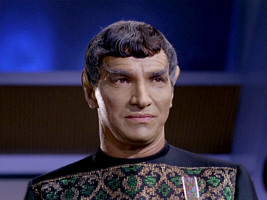
 Sarek in TOS: "Journey to Babel"
Sarek in TOS: "Journey to Babel"